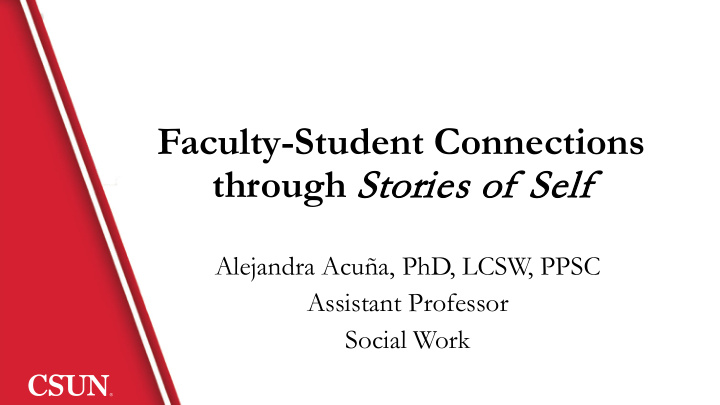



Faculty-Student Connections through Stories of S Self Alejandra Acuña, PhD, LCSW, PPSC Assistant Professor Social Work
We’re social beings and our brains are wired to connect with others. Our best learning happens in the context of a trusting relationship. We all, but particularly students of color, need to feel they are accepted, understood, and valued in an academic relationship and environment.
Relationships & the Brain The limbic system needs to feel safe, calm, and connected for the prefrontal cortex to regulate thoughts, learning, and goal- directed actions.
Story of Self • How do faculty connect with students on the first day of class and throughout the semester? • Is there a way that faculty can tell the story of their stories to connect with students?
Story of Self By telling a “story of self,” faculty can establish grounds for trust, understanding, relationship, and belonging. The power in your “story of self” is to reveal something of those moments that were deeply meaningful to you in shaping your academic life—not your deepest private secrets, but the events that shaped your academic journey. Learning to tell a good “story of self” demands the courage of introspection, and of sharing some of what you find.
M3 (Minority Male Mentoring) developed a series of poster stories written by men of color – faculty, students, and alumni. Their stories describe their ups and downs in higher education.
Theme: Universality (I am not alone) • “I’m not alone. We share similar life experiences.” • “I honestly got goosebumps reading these stories due to past experiences of mine replaying in my head.” • “I feel inspired because I too was on academic probation and I was even disqualified and now I’m back in my senior year.” • Thanks to those men on the posters, I feel less alone and more motivated to continue on my path.” • “Makes me feel like I belong too.” • “I feel like i am not alone in my struggles because i know that i am not the only one facing such difficulties. Reading the posters gives me more motivation to continue pushing through in order to create my own story.”
Theme: Lessons learned • “We all need someone to talk to that understands us and what we go through daily and what we’ve been through.” • “I found them to be inspiring and a way to remember where I came from and what I’m ultimately trying to achieve to change the cycle of how my life is supposed to end up.” • “The stories are really powerful as they all describe a story of overcoming life obstacles. Normally, one would use these obstacles as an excuse, but the stories on the posters are testaments that anything can be overcome. No matter the predicament one finds himself in.” • “Very inspiring and motivating to actually take serious pride in school and ask for help in regard to taking advantage of the resources at CSUN.”
Theme: Inspired positive emotions • “Felt determined and motivated to continue to work hard and excel as a first-generation college student.” • “Makes me feel like I belong too. Encouraging, motivating, and relatable. I like hearing their downfalls and not just their accomplishments. Shows truth and speaks louder.” • “I felt empowered, as if I should have written my own story to help others feel they belong. Feelings of hope.” • “They are all very inspiring. Makes the struggles I’m going through look less intimidating. Others who have gone through their struggles have succeeded so there’s no reason why I can’t either.” • “The experiences of those students are inspiring and send a strong vibe and connection.” • “I feel a sense of a warm hug, it gives me inspiration. Me, as a male minority, I sometimes feel ill motivated, but oftentimes seeing and reading the stories of those powerful individuals makes me feel like I can make it too!” • “These posters are essential for a person of color like myself. They serve as great reminders and inspiration. I often study late and walk past these posters which create confidence.”
A plot begins with a challenge and a choice. The choice yields an outcome , and the outcome teaches a lesson. Challenge, Because we can empathetically identify with the character, when we hear “about” someone’s courage; Choice, and we are also inspired by it. Outcome The story of a faculty member and their choices encourages students to think about their own values, and challenges, and inspires them with new ways of thinking about how to make choices in their own academic lives.
Crafting Your Own Story Develop your own “story of self ” by answering the following questions: Challenge: • Why did you feel it was a challenge? • What was so challenging about it? • Why was it your challenge? Choice: • Why did you make the choice you did? • Where did you get the courage (or not)? Where did you get the hope (or not)? • Did your parents or grandparents’ life stories teach you in any way how to act in that moment? How did it feel? Outcome: • How did the outcome feel? • Why did it feel that way? • What did it teach you? • What do you want to teach us? • How do you want us to feel?
Alejandra Acuña, PhD, LCSW Assistant Professor Please stay Department of Social Work connected aacuna@csun.edu
Question: What is truer than the truth? Answer: The story.
Poster Storytelling Campaign
Recommend
More recommend